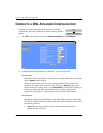
MM701G and MM702G User Manual 63
7
IMPLEMENTING A POINT-TO-POINT
LAN EXTENSION
Two ADC G.shdsl modems can be implemented in a point-to-point application (also called
back-to-back). In this application, the modems can be used to connect remote LANs to
create LAN extensions. In this point-to-point application, one ADC G.shdsl modem is set to
Remote mode and the other ADC G.shdsl modem is set for Central-Office mode. By bridging
traffic between these two modems, you essentially create one extended LAN that allows the use
of a single IP subnet.
Although you can set up multiple sessions on these modems, only one RFC 1483-Bridge
sessions is required for implementing a point-to-point LAN extension.
The ADC modems comply with the standard G.shdsl data rate range of 192 kbps to 2304 kbps.
Additionally, rates down to 64 kbps are supported only when using the G.shdsl modem in
single-pair, point-to-point mode for a LAN extension application.
BEFORE YOU BEGIN. . .
Determine which of these implementations apply for your application:
❑ Quick Install—If your application does not require custom configuration, you can use the
default modem settings. To implement, the Remote mode modem is already configured
with factory default configuration for implementing point-to-point LAN extension; no
changes are necessary for this modem to implement service. The Central-Office modem
requires only two configuration changes to set the modem to Central-Office mode. These
changes are described in “Complete a Quick Installation” on page 64.
❑ Custom Configuration—If you implement custom configuration where you do not use
factory default parameters for your modems, refer to “Complete a Custom Configuration”
on page 66 to configure the Remote modem and to configure the Central-Office modem.


















